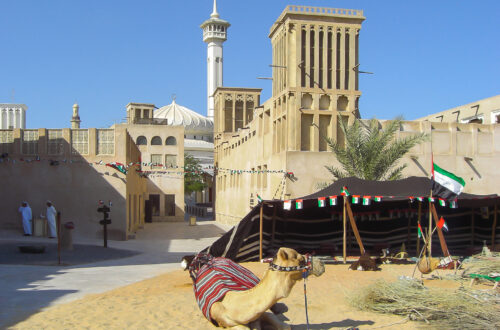Discover Hatta Dam: A Complete Guide
The Hatta Dam is a man-made marvel that was built in 1990 to store water from the Hajar Mountains and supply it to the surrounding areas, including Dubai and Sharjah. The dam creates a serene lake that spans over 2.4 square kilometers and has a maximum depth of 80 meters. The reservoir is surrounded by rugged mountains, rocky cliffs, and verdant vegetation, which make it a paradise for nature lovers, hikers, and photographers.
Hatta Dam: The Getting there
The Hatta Dam is located about 134 kilometers from Dubai and can be reached by car or bus in about 90 minutes. The nearest airport is Dubai International Airport, which is about 132 kilometers away. We recommend that you rent a car or hire a private driver, as public transportation is limited in this area.
Hatta Dam: The Things to do
Once you arrive at the Hatta Dam, you will be amazed by the variety of activities and attractions that await you. Here are some of the top things to do:
Kayaking and paddle boarding
The calm waters of the Hatta Dam are perfect for kayaking and paddleboarding. You can rent a kayak or paddleboard from the onsite rental shop and explore the lake at your own pace. You will be surrounded by stunning scenery and may even spot some wildlife, such as birds and fish.
Hiking and biking
The Hatta Dam area has several hiking and biking trails that cater to different levels of difficulty and distance. You can choose to explore the mountains, the desert, or the lake, and enjoy the fresh air and the stunning views. We recommend that you bring plenty of water, sunscreen, and a hat, as the temperatures can get high during the day.
Picnicking and barbecuing
The Hatta Dam has several designated areas for picnicking and barbecuing, where you can relax, eat, and socialize with your family and friends. You can bring your own food and drinks or buy them from the onsite kiosks. We advise that you follow the rules and regulations of the area and keep it clean and tidy.
Sightseeing and photography
The Hatta Dam is a photographer’s dream, as it offers endless opportunities for taking stunning photos and videos. You can capture the reflections of the mountains on the water, the clouds passing by, and the wildlife in action. You can also visit the Hatta Dam viewpoint, which provides a panoramic view of the entire lake and the surrounding area.
Hatta Dam: The History
Before we delve deeper into the wonders of the Hatta Dam and Reservoir, let’s take a moment to appreciate the engineering marvel that made it all possible. The Hatta Dam is a concrete gravity dam that was designed by the French company Coyne et Bellier and built by a joint venture between Dubai Electricity and Water Authority (DEWA) and a Swiss contractor, Impregilo.
The construction of the Hatta Dam began in 1985 and took five years to complete, at a cost of approximately 70 million USD. The dam is 80 meters high, 300 meters long, and has a storage capacity of 165 million cubic meters of water. The reservoir created by the dam covers an area of 2.4 square kilometers and has a shoreline of 7 kilometers.
The Hatta Dam was inaugurated on January 8, 1990, by the late Sheikh Rashid bin Saeed Al Maktoum, the former ruler of Dubai, who was a visionary leader and a driving force behind many of Dubai’s development projects. The Hatta Dam was one of Sheikh Rashid’s most ambitious projects, as it aimed to provide a reliable source of water for Dubai’s growing population and industries, as well as to promote tourism and recreation in the region.
Hatta Dam: The Geography of the Hatta Dam
The Hatta Dam and Reservoir are located in the Hajar Mountains, which are part of the larger Al Hajar Mountains range that extends from northern Oman to eastern UAE. The Hajar Mountains are known for their rugged terrain, deep valleys, and towering peaks, which rise up to 3,000 meters above sea level. The Hatta Dam is situated at an altitude of 200 meters above sea level, in a valley between two mountains, which gives it a unique and picturesque setting.
The Hatta Dam is fed by several streams that originate in the Hajar Mountains, which bring water from the monsoon rains and the underground aquifers. The water stored in the reservoir is used for irrigation, drinking, and industrial purposes, and is also a vital source of biodiversity, as it supports a variety of plant and animal species.
Hatta Dam: The Flora and Fauna of the Hatta Dam
The Hatta Dam and Reservoir are home to a diverse and thriving ecosystem, which includes over 200 species of birds, reptiles, mammals, and fish. Some of the most common species that can be seen in the area are the Arabian tahr, the mountain gazelle, the Arabian red fox, the common kingfisher, and the white-breasted kingfisher.
The vegetation around the Hatta Dam is mostly composed of acacia trees, date palms, tamarisk shrubs, and desert herbs, which have adapted to the arid climate and the rocky terrain. The Hatta Dam area is also famous for its wildflowers, which bloom in the spring and create a colorful carpet of red, yellow, and purple.
The Hatta Dam and Reservoir are protected areas that are managed by the Dubai Municipality and the Dubai Electricity and Water Authority, which aim to preserve the natural beauty and biodiversity of the region, while promoting sustainable development and tourism. Visitors to the area are encouraged to respect the environment, to avoid littering and harming wildlife, and to follow the designated trails and facilities.
Hatta Dam: The Cultural Heritage
The Hatta Dam and Reservoir are not only natural wonders but also cultural treasures, as they are located in an area that has a rich history and tradition. The Hajar Mountains have been inhabited by various tribes and civilizations for thousands of years, who have left their marks on the landscape
Conclusion
The Hatta Dam and Reservoir is a hidden gem that should not be missed if you are visiting Dubai or the UAE. It is a perfect place for a day trip or a weekend getaway, and it offers something for everyone. We hope that our guide has inspired you to discover the beauty and the serenity of this natural wonder, and that you will share your experience with others. Thank you for reading, and happy exploring!
The Hatta Dam and Reservoir is a man-made lake and water storage facility located in the Hajar Mountains of Dubai, UAE.
The best time to visit is during the cooler months, from November to April, when temperatures are mild and comfortable for outdoor activities.
You can enjoy a range of activities, including hiking, mountain biking, kayaking, fishing, and picnicking.
Swimming is not allowed in the reservoir for safety reasons, as it is a water storage facility and not designed for swimming.
Yes, you can bring your own equipment for hiking, mountain biking, and picnicking. However, kayaks and fishing equipment can be rented from vendors in the area.
There are no entrance fees for visiting the Hatta Dam and Reservoir, but fees may apply for some activities and rentals.
There is no specific dress code, but it is recommended to wear comfortable and appropriate clothing and footwear for outdoor activities.
Yes, you can bring your own food and drinks for picnicking and other activities. However, there are also several food and beverage options available in the area.
The area may not be fully accessible for people with disabilities, as some trails and facilities may have steep slopes and uneven terrain.
You can drive to the area, which is located approximately 115 kilometers from Dubai, or take a guided tour that includes transportation and activities.



